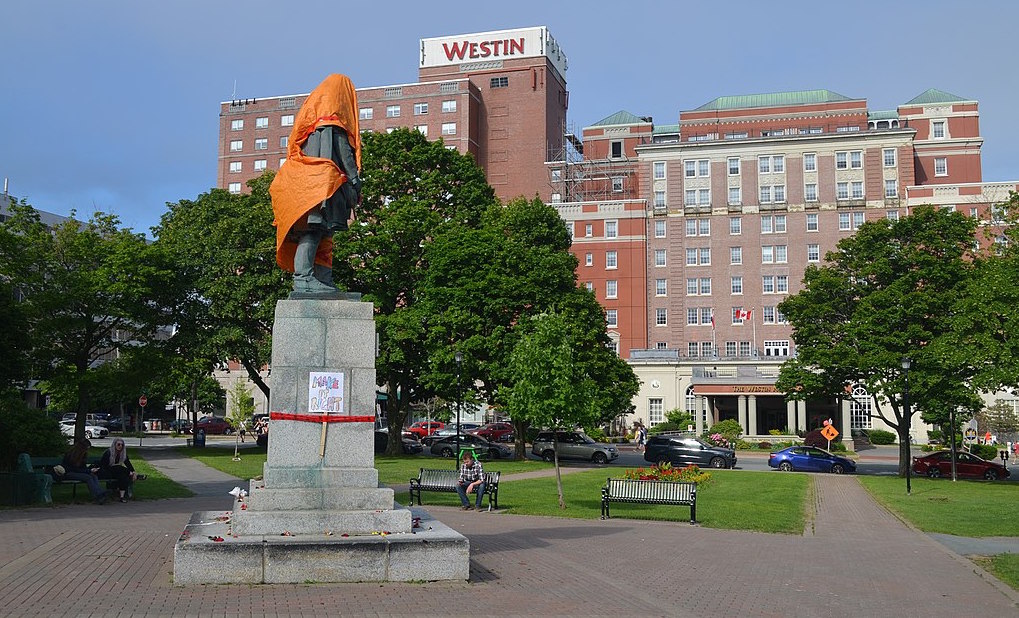When white nationalist neo-Nazis protested plans to remove a statue of Confederate General Robert E. Lee, placed on the University of Virginia campus in Charlottesville, Virginia in 1924, suddenly, people took notice of Confederate symbols in Canada.
In Montreal, someone complained about a Confederate plaque on Hudson’s Bay flagship store in the city’s core (there since 1957) and it was subsequently removed. Days later, however, the Confederate flag was proudly on display at an annual flea market in New Brunswick. These two incidents point to ongoing contradictions in our country. While some are ardently trying to right past wrongs, others cling to the past as a part of their identity in the present.
Confederate symbols pay homage to the “Lost Cause,” a belief among white southerners that their fight in the U.S. Civil War was a “noble” one. These symbols also disavow the extreme violence suffered by African-Americans post-Emancipation, such as lynching and Jim Crow segregation.
When I was a child, there were constant racist incidents, from being called the N-word to racist graffiti on our property in Scarborough. The recent debates over Confederate symbols and historic monuments made me think about my childhood memories, and the fact that other non-white Canadians might also have a difficult time reconciling the realities of their experiences and the symbols of Canada we are told to celebrate as “ours” even though they were built at a time when we were unequivocally not part of the nation. The Indigenous and Black activists who have been protesting these symbols since 2015 have forced us to confront historical fractures in our national story.
By removing statues like Edward Cornwallis (built in 1931), founder of Halifax in 1749, from a city park, and that of Egerton Ryerson (built in 1921), which sits on the campus of Ryerson University, we open a public discourse about who they were, the Canada of their lifetimes, and the period in which their statues were built. When we let these statues sit, unchallenged, unquestioned, decade after decade, we do little to confront the racism that is deeply embedded in their creation.
Rather than view these monuments singularly through the lens of remembering “heroes” from our past, we should see them for who they were — instrumental in the founding of the nation but also key figures in the genocide of Indigenous people, the implementation of residential schools, and the oppression of Black people and other racialized groups. By recognizing this duality, we do not erase history, but rather, we confront the problem of clinging to one version of Canada’s past in the first place.
I could not help but notice that in Canada 150 celebrations, we were inundated with reinsertions of the white, European settler narrative as “our” story, seen for example in the CBC miniseries The Story of Us. Non-white, non-English-speaking peoples were scarcely represented in this nostalgic sojourn into our past, even though we know from the historical record that we were there. Given these absences, it makes sense that some people don’t see what the fuss is all about.
For example, after the Elementary Teachers’ Federation of Ontario (ETFO) tabled a resolution to remove the name of Sir John A. Macdonald, Canada’s first prime minister from public schools in Ontario, the Angus Reid Institute conducted a national survey of more than 1,500 people in which it found that 69 per cent polled said that historical figures “should not be judged” by modern concepts of racism. If you consider that most history programs in high school and beyond ignore Black Canadian and Indigenous histories, what do most Canadians know of historical racism to begin with?
Removing monuments or renaming buildings calls upon the public to reflect on what they don’t know about “our” story not just in the past but also in the present. I had never heard of the white supremacist group the “Proud Boys,” who disrupted the Indigenous-led Cornwallis protest in Halifax. As they marched holding up the Red Ensign, Canada’s flag until 1965 when it was replaced by the maple leaf, their hatred was brought into plain sight. While some might dismiss them as being on the fringes, most experts estimate the number of hate groups to be nearly 100 and growing across the country.
Placing statues of historical figures such as Cornwallis in museums will allow for them to be placed in context but we also need an honest conversation about the increasing number of Canadians who cling to a Canada of yesteryear — a time when Black and Indigenous voices did not matter — refusing to consider other perspectives on our complex history. If people embrace what is happening and use this moment in the present as a catalyst to heal the wounds of the past we will be able to forge a path toward a truly inclusive future.
Cheryl Thompson has a PhD in Communication Studies from McGill University. She is the 2016-2018 Recipient of the Banting Postdoctoral Fellowship which she holds at the University of Toronto and the University of Toronto Mississauga. She also teaches courses on Black Canadian Studies and Visual Culture. She can be found on Twitter @DrCherylT.




